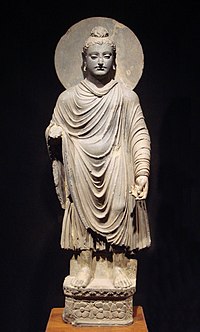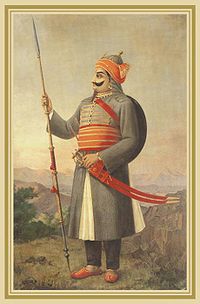History of clothing in the Indian subcontinent
Taking the instances of the sari to that of turban and the dhoti, the traditional Indian wears were mostly tied around the body in various ways.
[1] These little depictions show that usually men wore a long cloth wrapped over their waist and fastened it at the back (just like a close clinging dhoti).
Female statues and terracotta arts and figurines like a dancing girl also depict long hair probably braided and draped in cloth.
which were generally made of gold, silver, copper, stones like lapis lazuli, turquoise, amazonite, quartz, etc.
Indus Valley Civilization men are frequently depicted wearing headbands especially to contain hair bun at the back.
Some scholars, such as Jonathan Mark Kenoyer, have argued that headdress from the royal cemetery of Ur is an import from Indus Valley Civilization since similar headdresses have been found to have been depicted in many of its Mother Goddess figurines and actual ones discovered from sites such as Kunal and the floral depiction in gold leaves of species native to Indian subcontinent such as Dalbergia sissoo or pipal, and since no such ornamentation has been shown in Mesopotamian art itself.
The garments worn in the Vedic period mainly included a single cloth wrapped around the whole body and draped over the shoulder.
"Orthodox males and females usually wore the uttariya by throwing it over the left shoulder only, in the style called upavita".
Sometimes the poor people wore the lower garment as a loincloth only, while the wealthy would wear it extending to the feet as a sign of prestige.
In the Rig Veda, mainly three terms were described – adhivastra, kurlra, and andpratidhi – for garments which correspondingly denote the outer cover (veil), a head-ornament or head-dress (turban), and part of woman's dress.
The pre-Mauryan periods have been marked by the continuation of Indus arts and depict elaborate headdresses, conical hats with heavy earring.
[9]During the Mauryan dynasty (322–185 BC) the earliest evidence of stitched female clothing is available from the statue of a woman (from Mathura, 3rd century BCE).
Men wore Antariya (knee-length, worn in kachcha style with the fluted end tucked in at center front) and Tunic (one of the earliest depictions of the cut and sewn garment; it has short sleeves and a round neck, full front opening with ties at the neck and waist, and is hip length).
A statue of a warrior shows Boots (fitting to the knees cap) and a band (tied at the back over short hair).
As it is evident from many Ajanta paintings,[11] women used to wear only the lower garment in those times, leaving the bust part bare but these depictions may be a stylistic representation of mother goddess cult since Indus Valley Civilization.
Whereas women with stitched upper body garment or tunic have been shown from pre-Mauryan period as early as 400 BCE in a folk art depicted on Pazyryk rattling mirrors.
Depictions from terracotta clay tablets from Chandraketugarh show women wearing clothes made of muslin.
The main costume for the king was most often a blue closely woven silk antariya, perhaps with a block printed pattern.
Ancient Indians wearing kurta and baggy pants like shalwar have been depicted in 8-10th century CE ivory sculpture of an elephant chess piece from Bibliothèque Nationale, Paris, France.
[13] From the Late medieval period, there are increased evidences of pajamas and shalwar becoming common in Indian attire while unstitched dhoti keeps its prominence as well.
During the Mughal period, there was an extensive tradition of wearing embroidered footwear, With ornamented leather and decorated with the art of Aughi.
Rajput's main costumes were the aristocratic dresses (court-dress) which includes angarkhi, pagdi, chudidar pyjama and a cummerbund (belt).
Angarkhi (short jacket) is long upper part of garments which they used to wear over a sleeveless close-fitting cloth.
"To capture the sensuality of the female figures in Rajput paintings, women were depicted wearing transparent fabrics draped around their bodies".
[16] Rajput women's main attire was the Sari (wrapped over whole body and one of the ends thrown on the right shoulder) or Lengha related with the Rajasthani traditional dress.
Widows and unmarried women clothed themselves with Polka (half sleeved which ends at the waist) and Ghaghra as a voluminous gored skirt made of line satin, organza or silk.
During the British colonial period, Indian clothing went through many changes and began to reflect an evident European influence.
At first, this included combining elements of Indian and Western clothing, as some men would wear a 'dhoti' (loose lower garment) with a shirt and coat.
Although one major difference that remained between Indian and European men's fashion was the style and etiquette of head coverings.
In fact, we can see that small-scale artisan clothing producers did not disappear from India during the 20th century as they continued to make up a significant share of industrial output.






